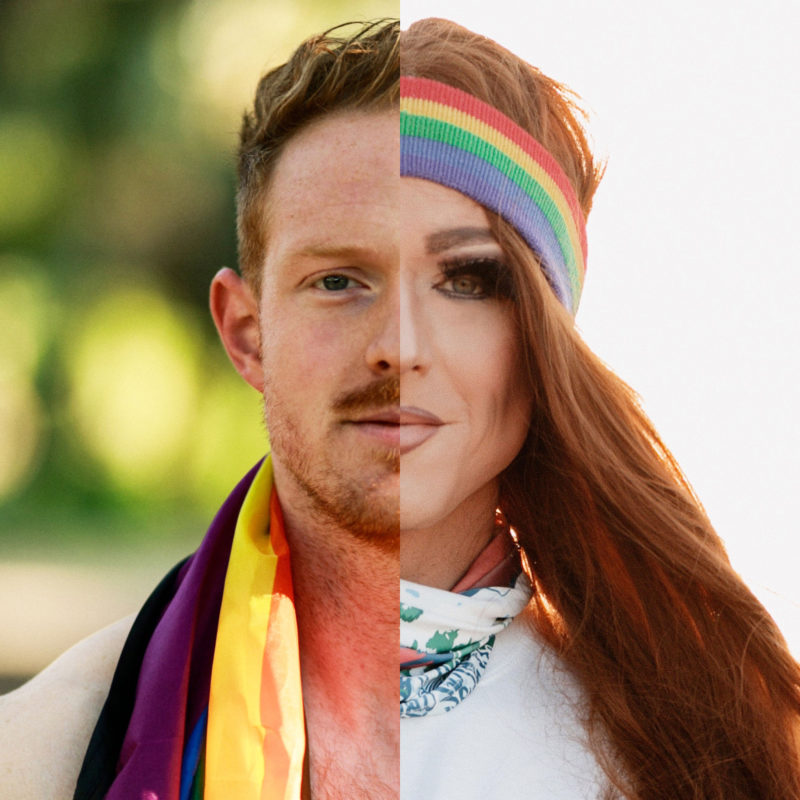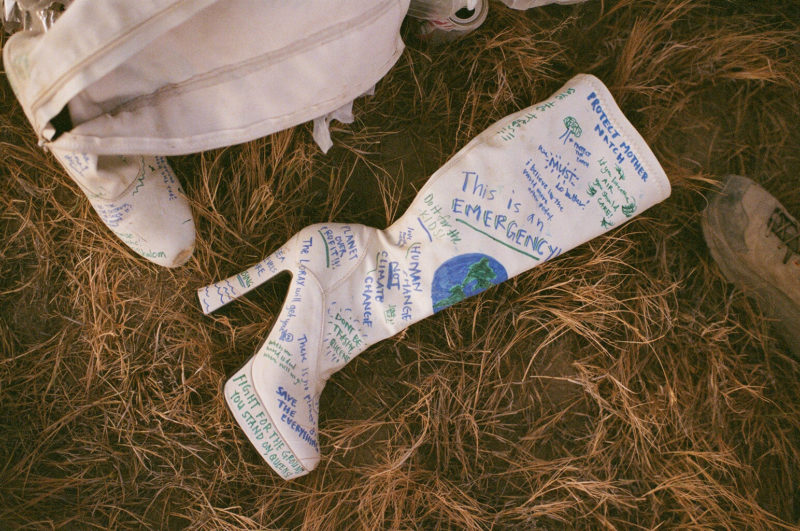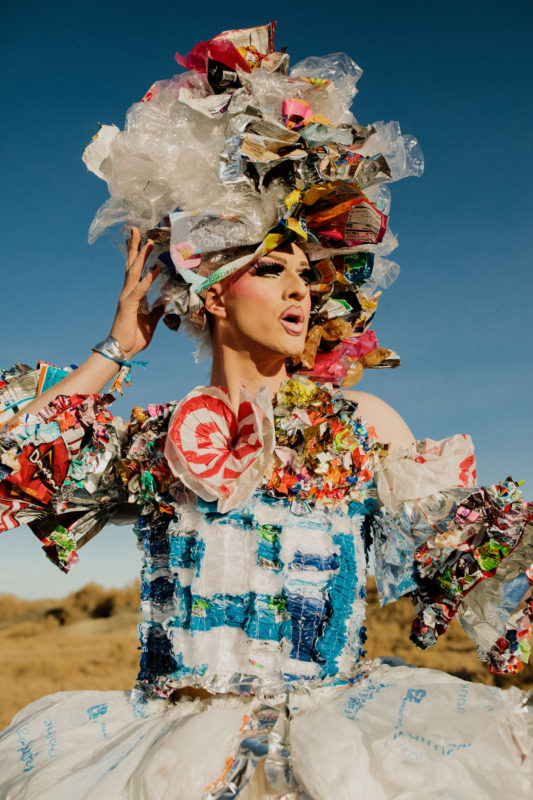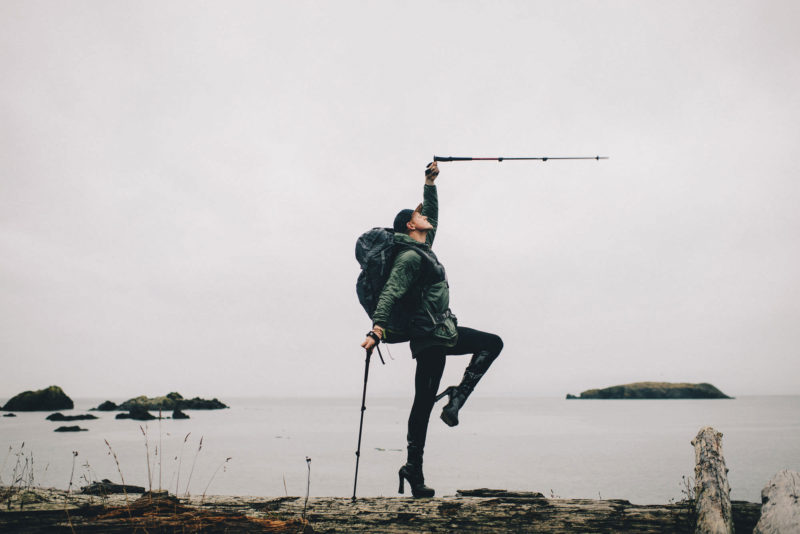Here at tentree, we have a term called “Environmental-ish.” and it’s part of how we’re making environmentalism inclusive. Living environmental-ish means taking small earth-first steps that add up to big change for our planet. That could be bringing tote bags to the grocery store (when you remember), or drinking from a reusable water bottle, or buying organic produce. We’re here to celebrate every meaningful step towards a better planet, even imperfect ones.
In this series celebrities, influencers, business leaders and everyday people share the details of their sustainability journeys, and the wins and fails along the way with the hopes that we can make sustainability more inclusive and that you can be inspired to live a little more environmental-ish.
We were so excited to chat with Pattie Gonia — queer environmentalist and photographer who’s bringing drag, diversity and community outdoors — about growing up outside, intersectional environmentalism, and drag makeup.
Q: For those who don’t know you, tell us a little bit about yourself and what you do.
Hmmm, how would I describe myself? I’m a proud ginger, frequently sunburned, professional homosexual who wears high heels on a trail near you.
Q: I’d love to hear a bit about your environmental-ish journey. Who/what first influenced you to care about the planet?
I’ll be honest with y’all, I grew up in rural America. Like middle of nowhere — imagine Medicine Hat, Canada but in America. Caring about the environment was really important in the farm culture I was from. My grandma owns a farm, and it was really important to her to care about the land through her work.
It was also really important to me since I spent my entire childhood playing in the backyard. So I’ve always had nature in my life, but it wasn’t that mountain top, outdoor culture, peak bagging experience. It was oftentimes a more rural experience.
I mean, I remember jumping off a swing set and performing “Cats” the musical for an audience of no one, so I’ve been living in Mother Nature’s house since forever. So that’s what inspired me to love the outdoors, but I don’t think I really started caring for the outdoors until I set foot into Pattie’s heels.
The journey with Pattie has been a catalyst for a lot of change, and the realization of my responsibility as an outdoorist to give more than I take — to truly give back to environments, to recognize my privileges, and to think about all the tools I have in my toolbelt to take action for our climate as well.
It’s been a journey of strutting, falling down, and getting back up again, and then falling down again. Through this I’ve learned that we all have a responsibility — especially if we love the outdoors — to care about the spaces we spend time in, and also care about ourselves and our fellow humans. I think we can often forget that we are nature too.
We have to be connected to nature. We fight for what we love, right? I think if we fall in love with nature, then we’ll be even more equipped to fight for it.

Q: Living sustainably is about progress, not perfection. What’s been your experience of this on your journey?
It’s really easy to feel defeated because perfection — and the gatekeeping of the environmental movement — makes us feel like any decision we’re making, we’re doing something wrong.
First of all, I’ll remind any of you reading this that the responsibility is not just on you as a consumer, but that doesn’t mean you don’t need to be responsible too. I think we all need to be responsible.
A really beautiful place to start is to ask yourself, “what’s the work that’s available to me and only me?” or “what are the decisions I make in my daily life that I can control?”
And I think more often than not, it’s about not doing certain things. Maybe it’s just purchasing a few staple items from tentree and having that as your capsule wardrobe. Maybe it means buying from an ethical brand. Maybe that means not buying anything at all. Maybe it means creating a little bit of plastic waste in order to support a local, BIPOC owned takeout restaurant. And knowing that’s okay!
None of us do this perfectly. For myself, I’m often thinking, “what are those 1% changes you can make that can inspire more change in your life to come?” What I know from my journey so far is that a snowball effect happens, but it only does when I give myself grace.
Also, I’m motivated when I know that I don’t have to do this stuff alone. I get to learn how to live more sustainably with a community. I get to learn from other people about their sustainability hacks, what they’re doing, what’s working for them. So for me, it’s about community too.
I think it’s really easy to think of our lives in terms of individual actions, but what we aren’t seeing is the collective action that’s making. Just look around you — if companies aren’t eco-minded anymore, they’re not surviving and they’re not thriving. And that’s because of the collective action of consumers.
When we look at what we can do, it goes beyond consumerism and capitalism into policy change. When we vote a certain way to protect the environment, it signals to people that we care. So, collective action is so powerful.
There’s also intersectional environmentalism. That’s simply using what you care about, the work that’s available to you and only you, and chasing after the intersections of those questions with the environment.
For me, that means intersecting my love of climate with the queer community, and building queer community that cares about climate and also spends time outside. But that’s not going to work for another drag queen who doesn’t spend their time outside.
We all need to embrace who we are, and when we can start the environmental movement with our identity, it’s going to feel so much better, and we’re going to be able to make so much more impact.
Q: Are there any environmental-ish lifestyle choices you make that you’d be willing to share?
I love that we’re talking about this, I think living imperfectly is something that doesn’t get talked about enough. A framework I like to think about is allyship. In allyship, we all know we will mess up, and when we do, we need to own it and take accountability for our impact, and then just do better next time. Get back up and try again.
I think it’s so easy to feel defeated when it comes to living more environmentally conscious. Let’s just recognize that there are a lot of forces at play here. Not only our own internal dialogue, but the energy of our world, where we don’t feel like we have any space to learn anymore because we feel like we have to be perfect or we’re cancelled. I think there’s a world beyond that, and I really want to be a part of communities that meet people where they’re at and help them succeed. I think that’s what we can do for each other.
So, to your point, when you ask about how I live environmental-ish, I’m like “lol, everything in my life?”
Something that was on my mind this morning: drag. I’m using so much makeup to create this look. I’m literally painting a different version of me on my face. So that means for me, the light mineral makeup that’s eco-friendly, doesn’t work. I have to use products that aren’t necessarily the most environmentally friendly.
But what that means is that I can choose to just use those products, and not buy excess of what I don’t need. I don’t get the newest eyeshadow palette when it’s released just because I want it. Instead I use what I have and use it until the end of its life. So literally, my lip pencil is *this* short now because I’m determined to use every little bit of this thing!
So it’s all about the little things you can do too. You know, with drag, this wig is 100% plastic. And I hate plastic. But I’m going to wear this wig and rewear this wig until it literally dies a fiery death. I think as people we feel pressure to always strut a new look. But I think when we see someone wearing an outfit for the third day in a row, we should celebrate that! When I see that, I’m like “I see you, and that’s me too!”
Last month I emailed Kryolan — the brand of makeup that I wear as my foundation — and I was like “hey y’all, have you thought of sustainability efforts?” Because I want to know and lightly pressure them to do better. It’s a shared, mutual, community-based responsibility that we all share to do better by our planet.

Q: Could you tell us about the intersection of environmentalism and the LGBTQ+ community?
Well first, I want to acknowledge the huge amount of privilege that I hold. While I am a queer person, I’m also a straight-passing white male out of drag, and therefore I hold a lot of privileges that my fellow community members don’t. A lot of my community members are also people of colour, a lot of them are trans. I can go into the outdoors, put on drag makeup, and wipe it off at the end of the day. A trans person can’t.
So I think we need to recognize that when we’re talking about this stuff, we’re not just looking at me. You’re looking at a community that’s far more diverse than me and that faces a lot more barriers than I do. That’s a huge amount of privilege, and that’s why I feel really passionate about this work.
My friend Erin, who’s trans, loves to climb mountains. She has to stop at 35 different gas stations and rest stop restrooms before she even gets to where she wants to go to enjoy the outdoors. Those are often experiences where she’s told that she’s using the wrong restroom, or she’s told that she can’t use the restroom. That’s so messed up, and those are the things we don’t even think of. All the little barriers we don’t even think of.
What a privilege it is that I even have a car and have the ability to travel to these national parks that I want to visit. We’re wondering why we don’t see more people of colour or queer people or disabled people in the outdoors, well, they have far more barriers to access.
To your point, since middle school I was told that I was gay, and the outdoors was weaponized against me — I was told I was unnatural and that there was nothing else gay in this world. When in reality, nature is fabulously queer. In fact, the environments that thrive the most in this world are queer. And I don’t mean it’s queer as in two male penguins fostering a little baby penguin. That’s great and that’s cute, but nature is so queer and weird and creative in how it creates solutions.
Most flowers have the ability to pollinate themselves, same with trees. There are fish that change genders multiple times in their lifetime. We’re seeing intersex birds — birds that carry both gender traits — all the time because we’re looking for them now.
So it’s a fascinating queer world, and being outdoors and taking up space in the outdoors is important to me because I think for queer people, nature can be one of the most healing spaces. I think it’s the same for any marginalized person. Again, if we can connect to nature then we can fight better for it, and I want queer people to fight for nature because nature is weaponized against us.
That’s all the serious stuff, but it’s actually just really fun!
I think something that people wouldn’t really know is that this journey with Pattie was the first time I’ve ever given myself queer community, especially outdoors. It’s really special to me, and some of my closest people are those I met through queer connections in the outdoors.
So no matter what that identity is for you, know that putting yourself in a more unlikely environment (especially if it’s outdoors) and then creating space for other people that hold your identity to get out there too, is so important and so needed.
To those who aren’t part of a marginalized community, you’re part of a community of allies, and I think that ya’ll don’t realize the power you hold to eff sh*t up from the inside out, to truly be there for the underdog.
Being an outdoorist to me means being an ally for others who you share the outdoors with, and to be an ally for the planet as well. I think I often felt like I was at the sidelines because I was like, “well, I’m an ally and I care a lot, but I don’t know what to say or what to do.”
Use your voice, speak up, use your unique privileges to advocate for other people. There are so many people who need your voice and need your allyship, never forget that.

Q: What are some practical ways that these barriers can be removed?
I recommend that members of the queer communtiy just get outside, but do it in a way that meets them where they’re at. The outdoors is not just this “let’s go hike 45 miles” moment all the time.
Maybe for you that’s getting a queer best friend and going birdwatching around your nieghborhood, or painting your fingernails in your backyard. Those experiences are just as important and just as beautiful as the mountaintop moment the outdoor industry loves to celebrate as the only way to get outdoors. Get out there whatever way works for you, and make it a community based thing.
Also realize that some time out there alone can be beautiful as well. I often feel like the farther away I am from the internet, and from the energy from cities and society, the healthier I am.
Also, realize it’s a journey. Maybe you’ll get out there and you’ll find you’re not able to complete the hike you wanted to, or the route you wanted to climb. That’s okay! Give it time.
Q: Do you have any go-to resources for the LGBTQ+ community and those who want to support them when it comes to sustainability, environmentalism and the outdoors?
I’m going to shout out some Canadians here. If y’all don’t know who ASAPScience is, they’re two incredible queer science YouTubers who also share a lot about environmentalism.
My favourite Instagram account is @climemechange. You think it’s a meme account, but it will subtly jab you with the hard truth and make you think real hard.
There are so many incredible, diverse people who are leading the climate movement these days. @greengirlleah is one of them, she founded The Intersectional Environmentalist.
Dr. Ayana Elizabeth Johnson is a black marine biologist who has a podcast called “How To Save The Planet.” That’s a super amazing, accessible resource. I love listening to podcasts and I can’t recommend it enough. It debunks things I never would have thought of in the environmental movement.

Q: What tips would you have for someone who wants to live eco-friendly but doesn’t know where to start?
My number one piece of advice is to take it one strut at a time. You’ll be amazed by the snowball that will develop in your life. I think a really cool part of that snowball effect is not only when you make it a daily part of your life, but you make it a daily part of the community around you. You can make it fun, make it with friends, and make it feel like you’re not going the road alone.
Meet yourself where you’re at and don’t beat yourself up. There are already enough forces out there that want to do that to you — don’t do it to yourself.
I think at the end of the day in the climate or environmental movement, it’s not necessarily using one less piece of plastic. It is, but also it’s also about finding the work that’s available to you and only you. Maybe that means advocating for a recycling program at your place of work, maybe that means you picking up a trail that you spend a lot of time on and stewarding that trail. There are so many ways we can uniquely do work to better our planet, and we all need to do that work that’s unique to us. No one else has the ability to do that.
One of my favourite quotes is from climate justice writer Dr. Mary Heglar, “The thing about climate is that you can either be overwhelmed by the complexity of the problem or fall in love with the creativity of the solutions.” When we can think about how much is possible in the climate movement, when we’re motivated by the creativity and the possibility and the abundance of ways we can approach it, then I think it feels more natural and will lead to lasting change.
Whether this interview left you feeling inspired to give bird watching a try or listen to a new podcast, we’re here for it. No matter where you are on your environmental-ish journey, you’re in good company.
We believe that the outdoors should be enjoyed by everyone. Join the conversation! We’ll be highlighting LGBTQ+ voices on social and on The Environmentor during Pride month and beyond.

